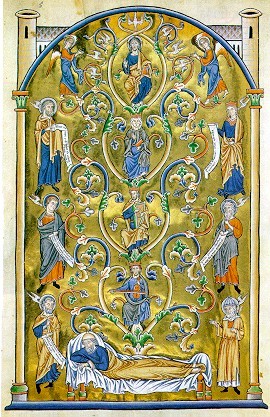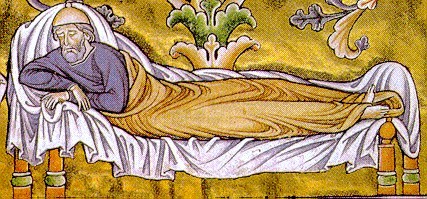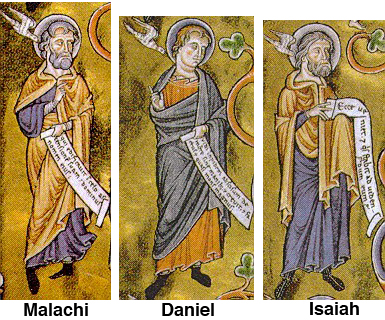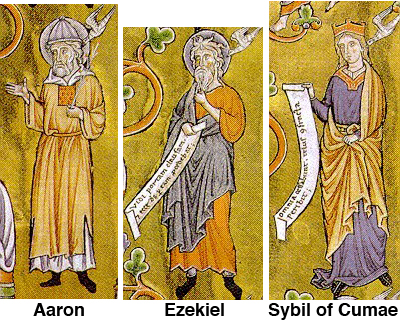Jesse Tree: Ingeborg Psalter
Jesse Tree: Ingeborg Psalter
– Father Johann G. Roten, S.M.
Sometimes called the root of Jesse or radix Jesse in Latin, the Jesse tree is a visual representation of Jesus' genealogy which dates back to the father of David who was Jesse. The biblical references used habitually to establish Christ's descent from David are the following:
• Is 6,14; 11,1; 53,2
• Num 24,17
• Mat 1,1-16
• Lk 3,23-38
• Rev 22,16
In sacred art Mary is also depicted as part of Christ's family tree named after Jesse.
The Fathers of the Church and Latin hymns refer to the tree of Jesse not only when speaking about the line of David (radix Jesse) but also when speaking of Mary (virga ex radice = branch or offshoot of the root of Jesse) and Jesus (flos ex virga = flower that blossoms on the branch). Based on these literary sources, the visual rendering of the Jesse tree shows Jesse in reclined and slumbering position, a tree growing out of his body on whose branches a changing and diverse group of ancestors can be observed.
The tree which is patterned after the tree of life in paradise and the cross as the definitive tree of life habitually shows a series of kings of the Solomonic line, or prophets and evangelists. The top of the tree is composed of Mary, Jesus and angels, sometimes with reference to the gifts of the Spirit. But variations are frequent. The artistic motif of the Jesse tree is know beginning in the eleventh century and seems to have disappeared in the sixteenth century. During the time of bloom it found many and diversified ways of realization from illuminations to bronze doors (for example, St. Zeno, Verona). The example presented here is taken from a psalter of the thirteenth century, the so-called Ingeborg Psalter (1210) conserved today in Chantilly, Paris.

The tree is highly stylized and of sophisticated ornamentation. Jesse is lying on his bed more pensive than slumbering. He wears the typical Jewish hat. From the mid-section of his body or rather behind it, the trunk of the tree rises to a height of four levels or tiers each once of them in the shape of a chalice.

They show in ascending order [from left to right] Abraham, David, Mary and Jesus Christ. It is the royal line. For this reason all figures except Christ wear crowns.

They are flanked by Old testament figures on both sides. We have on the left: Malachi standing next to Jesse followed by Daniel and Isaiah in ascending order.

To the right of Jesse we have Aaron, Ezekiel, and an exception to the group of prophets, a feminine figure which represents the Sybil of Cumae.

These figures are in all likelihood characters taken from a mystery play, the so-called mystery of Rouen. They present, with the exception of Aaron who is designated as high priest and holds the blooming staff, open scrolls with part of their vision about the coming Savior (not necessarily corresponding to the exact Scripture quote). The Cumaean Sybil reminds the reader of the finiteness of all creation. Ezekiel speaks about the closed door (reference to Mary's virginity) through which God alone will proceed. Malachi proclaims the grandeur of God's name, whereas Daniel in his visions of the four beasts celebrates God's definitive victory over evil. Isaiah announces the rule of Immanuel. The dove next to the prophet's head indicates the presence and inspiration of the Holy Spirit.
Jesus Christ, who is enthroned at the top of the tree which, in fact, is not a tree but an edifice symbolizing the house of David, rules as the Pantokrator both blessing (right hand) and judging (book in the left hand). He is surrounded by two worshiping angels and the seven doves, symbols of the seven gifts of the Spirit: "The Spirit of the Lord shall rest upon him: a spirit of wisdom and of understanding, a spirit of counsel and strength, a spirit of knowledge and of fear of the Lord, and his delight shall be the fear of the Lord." (Isaiah 11,2-3)
All About Mary includes a variety of content, much of which reflects the expertise, interpretations and opinions of the individual authors and not necessarily of the Marian Library or the University of Dayton. Please share feedback or suggestions with marianlibrary@udayton.edu.
